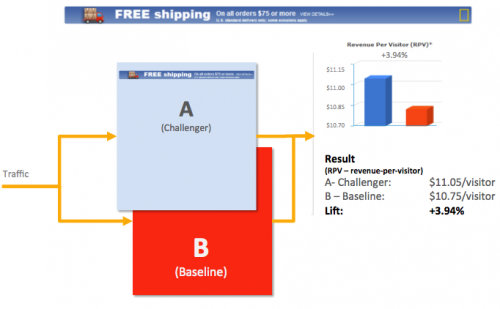Measure Your Success Using Revenue Per Visitor

In other words: RPV= total revenue/# of visitors. And while many might consider RPV a poor man’s version of conversion rate, it’s important to note that this composite metric can measure your success with valuable insights that simply aren’t offered by any other isolated statistic.

To begin with, RPV is an important number because it lets you know exactly how much each customer is worth to you, on average. While it is important to view customers as individuals and note their own special snowflake-like value, it’s also necessary to calculate how much capital they’re bringing in, especially in comparison to the amount they’re costing you.
After all, if you’re spending more on average to get a conversion than you’re making on the average conversion, you’re losing money on almost every purchase. That means that RPV is vitally important to adjusting your overhead costs, as well as honestly assessing the success of your business. If you have a particularly low RPV, you know that you’ve got some work to do. You need to be attracting more valuable customers, or at least work harder to upsell some of the visitors you’ve already got.
That means RPV is automatically your measuring stick for every lead generation effort you’ll ever undertake. The goal with driving traffic to your site is not just to acquire visitors, but valuable visitors. That is, enough visitors who are going to make high dollar purchases that validate what you’ve spent on advertising. A high RPV combined with a low cost per conversion rate can handily justify your marketing budget.
If your newest battery of diversified marketing campaigns is costing you $24.00 per conversion and your RPV is sitting around $25.00, you’re just barely treading the water on your overhead costs. You need to better target your customers, increase prices, or cut overhead costs; or possibly do all three. You’re missing out on a lot of profits somewhere in this equation, and you’d never know if it weren’t for your careful monitoring of the RPV.
Why RPV is more important than conversion rate
Don’t get it twisted, conversion rate is very important. RPV however gives conversion rates a lot of context that their missing when measured in seclusion. This is because different conversions are for different amounts of revenue, they vary in product quantity and price, and a high conversion rate doesn’t necessarily mean higher revenues. To exemplify, imagine a series of customers making low dollar purchases, your conversion rate is raising accordingly, but your revenues aren’t exactly skyrocketing.
Taking conversion rate as the end all and be all of your metric analysis can be very misleading in regards to your bottom line profits. It’s for that reason that RPV and other more specified metrics like it are so valuable.
Another useful aspect of the RPV metric is its propensity to tip you off to big problems with either your marketing campaigns or your website itself. If you see a sharp decline in revenues per visitor it could be indicative of a vast migration of lurking non-buyers to your site. This is a marketing problem that should be addressed as soon as possible. You want valuable traffic, not a bunch of window shoppers.
Alternatively, if you’re still receiving tons of traffic but your RPV is dropping off you may have an issue with your CTA button, an add to cart clicking error, slow page load times, or any number of other UI difficulties. You’ll need to take a test run through your sales funnel and find out exactly where the problem lies.
RPV combined with A/B testing, can also be an excellent indicator of what changes you can make to your site that promote conversions or cause them to decrease. Manipulating single factors during a testing phase and measuring the effect on RPC can show dramatic results in the overall value of the variables you’re changing. As always make sure you allow that testing phase to last at least a week, and don’t end it before both variants get at least 100 unique visitors each.

This seemingly superfluous metric can actually be quite helpful whenever you want to measure your success, and should be a mainstay on every serious marketer’s metric measurement dashboard. For more information about vital metrics to measure, check out our comprehensive 2-part post series on the subject, or contact Ashop support and see about setting up your own dashboard for your online store.














Comment(s)1
http://www.ecommercemarketer.com.au